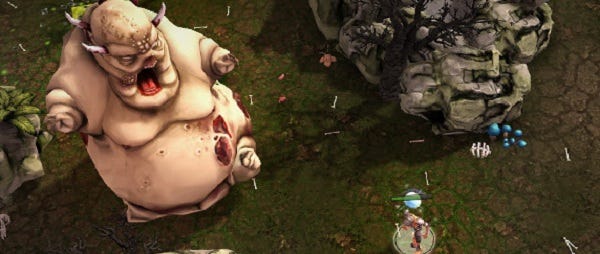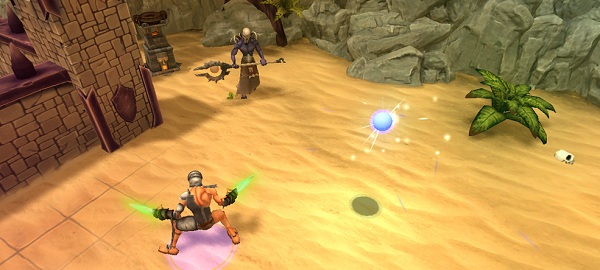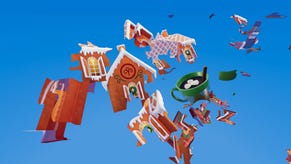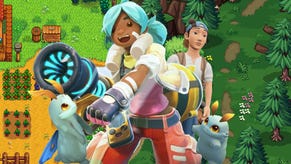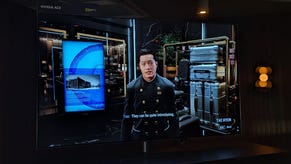Impressions: Forced Demo
Into the Danger Zone
Forced is a co-operative arena-based ARPG, currently around half-way toward a successful funding campaign on Kickstarter. Developers BetaDwarf sent me a demo of the game, which has been in development for almost two years. The first thing I noticed is that I shouldn't really keep calling it an ARPG in the Katchup, since it's more like a tactical action game than a roleplaying game. Then I realised I was going to have to involve a friend if I wanted to experience the game at its best, and so I did. Now I understand what Forced is and it's not quite what the videos had led me to believe.
Forced isn't really an ARPG at all. It controls more like a top-down shooter, with WASD moving the player and the mouse aiming and attacking. And there's no loot. It's as simple as that. If a pair of pants don't fly out of an undead monster when it dies (again), then the game is not an RPG. How can I play a role if I'm not upgrading my trousers every once in a while? Instead of loot and levelling, there are skill unlocks and increased tactical understanding. Your character does become more efficient, with successes providing crystals which open up new abilities, but the game is designed to allow the players' skills to increase rather than their avatars'.
There are no multi-tiered quests or epic journeys and the small scale could be a little off-putting. It's a gladitorial combat game, with parties dropped into arenas a few screens in size and provided with plain objectives: activate six shrines or kill an elite monster. That sort of thing. The monsters are held behind gates around the arena and as each stage of the trial is completed, more will be allowed in, sometimes varying in type.
They're not the sharpest teeth in the skull but when a wave arrives, it can take careful management of their movement and positioning to finish them off without taking severe damage. Arenas tend to have obstacles scattered about them and the most effective tactic I've discovered is to have one player tag the monsters with a bow, while the other leads them on a merry chase, smashing them to pieces once they're bristling with arrows.
The co-operative element of the game provides two main tactical considerations. One is the presence of the spirit mentor, an orb that sounds like a garbled recording of a Martian professor, and the other is the MMO-like 'marking' system. There are four weapons to choose from when beginning a trial and each is essentially a class. There's a sweeping, powerful attack that can strike multiple targets in an arc, there are excellent, rapid stabby knives, there's a magical shield-thing and there's a bow. Each has its own secondary skills, more of which are unlocked as a player progresses through the trials. Whichever weapon you wield, hitting an enemy with it leaves a mark on the creature and the more there are, the more damage any special attacks that connect will inflict.
Here's how that worked in practice. I liked dual-wielding stabby blades. They strike with such speed that there's barely time for more than a single frame of animation. Poised, STABBING, poised, STABBING, one blade punching out, then retracted as the other strikes. Of course, like anything in a computer game that is fast, stabby blades are weaker than slower, ponderous hammer blows, even if they are stabbing something directly in the eyes and brainstem.. That's just the way things work. However, rushing into the middle of a group of enemies and whirling around, nicking them with pointy precision, leaves them marked up and vulnerable to a mighty finishing move. That's where the big gun steps in, smiting everything with a volcanic death-blow. Teamwork, see? The blademaster just has to keep moving, herding and preparing the crowd, while his bulky buddy waits for the perfect moment to unleash his power.
Or, since it's possible to switch class at the beginning of each trial, you could go for an archer and shieldbearer combo. The archer would most likely be doing the tagging as it takes time to 'charge' the bow, while the shield absorbs any incoming damage. Meanwhile, objectives can interrupt the herding and hacking by forcing a change of plans. To activate shrines, for instance, it's necessary to use the orb. Billed as an extra party member of sorts, the orb hovers in mid-air waiting for instructions. It can be summoned by any player to the exact point they currently occupy and as it is intangible, it'll drift straight through any objects. In order to utilise a shrine, whether as part of an objective or to activate its special ability, it's necessary for the orb to pass through it.
Co-ordination is required. I'd often dash to a corner, being chased by toothy demons, call for the orb and then rush off to the opposite corner of the arena, preparing to drag it there afterwards. When placed like this, the orb doesn't follow the player's movement, it heads straight to the location they were at when they summoned it, so directing it around the arena involves forward planning. Where do you want to be next, how many enemies are in the way, and where are your team mates? Quite often, as it turns out, those team mates have a plan of their own and the orb ends up drifting, confused, with no real purpose. Just as it's important to have a tagger and a finisher, it's important to have an orbherder. With up to four players available, things could become confusing without leadership and some of the later trials are frantic enough with two.
That's all good news. Forced is already in a good state and it doesn't play quite like anything else, with elements of MMORPG mechanics in its combat, despite the fast, responsive flow. The biggest hurdle will be providing enough variety to keep players coming back, particularly since the trial areas are so small. That could be limiting but as the game's tactical drive is about control of space and movement, perhaps something would be lost on a bigger stage. The biggest danger is that bouts can feel inconsequential and slight, given that the main purpose is simply to collect crystals in order to become stronger for the next trial. That said, it's a game about co-operative combat and it does demand communication and, crucially, creates some hilarious disasters when wires are crossed.
BetaDwarf address the query that the game might be an ambitious design, considering that it's their first game. Technically, they already have a good looking build - conceptually, they have something that goes against some of the expectations its appearance might suggest. Although I've enjoyed a couple of hours with the game, I do find myself wishing there was more to do in between trials - I'd like to build a team of gladiators and feel more a part of the world. But within the arenas, Forced is certainly on to something. It's compact, controlled and co-operative. And there are no magic pants.
Forced is on Kickstarter right now.
